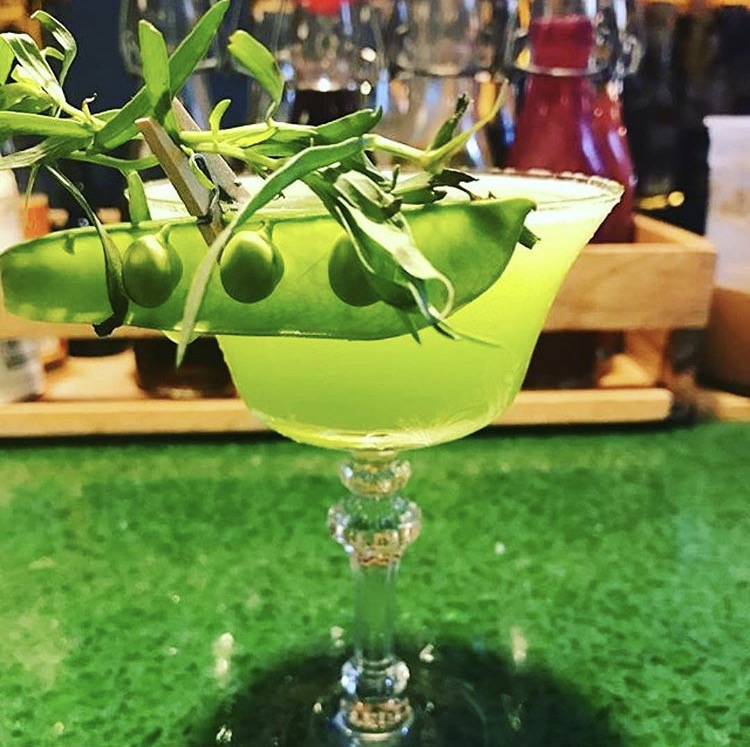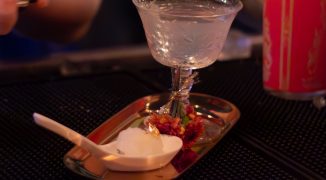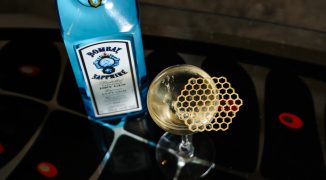On a busy Friday night at the I/O rooftop lounge of the Godfrey Hotel in Chicago, the signature drinks aren’t made behind the bar. Instead, the “cocktail chef” is shaking, stirring and whipping them up in the kitchen. The idea for having a cocktail chef came from executive chef Nathaniel Cayer’s stage at Grant Achatz’s chef-driven, molecular gastronomy restaurant, The Aviary. “Every cocktail is prep-intensive,” says Cayer. The culinary cocktail trend leans heavily on kitchen traditions, borrowing ingredients, mindset and inspiration to build more thoughtful libations.
It helps, Lee Zaremba, Beverage Director for the Boka Restauran Group in Chicago, says, if a bartender starts thinking like a chef. “You have to have that mental spot of really having a respect for the ingredients,” Zaremba says. “Don’t find an apple puree. Go and find apples. Start from scratch.” Zaremba’s bartenders do all their prep work in their restaurants’ respective kitchens. “When you’re in the kitchen, you’re gaining more knowledge, and bartenders can enrich their own creativity.”
Kitchens aside, Restauration in Long Beach, CA, owner Dana Tanner makes culinary-inspired cocktails with limited space. “We have a very small bar,” Tanner says. “The only thing made in the back is the bloody Mary mix. Everything else is made at the bar. We have this beautiful, big cart with hanging baskets out front in the restaurant that people think is for display, but it isn’t. It’s for storage.” Zaremba and Tanner agree that just about any ingredient used in the kitchen can be used as the basis for or as an enhancement to cocktails. Fruits are especially good to infuse syrups and reductions. Vegetables can add a savory note. Herbs can also be used by themselves or with fruits and vegetables to flavor and enhance cocktails.
Similarly, at Kimpton Hotels and Restaurants, the line between the kitchen and bar is becoming blurred, says Faith Yi, senior manager of the hotel group’s external communications. “They’re inspiring each other, sharing ingredients,” Yi says. So much that a recent survey of the hotel group’s bar managers determined that 91 percent of their bartenders are using vegetables in their cocktails. “It’s something that really resonates with guests,” says Mike Ryan, director of bars for the Kimpton Hotel group. “Our bartenders are working with avocado, carrots, tamarind, fresh radishes, kale juice. It’s giving guests something they likely haven’t seen before.” At the Firefly at the Kimpton Hotel Madera in Washington, D.C., lead bartender Brendan Ambrose combines Plymouth gin and Cointreau with a sugar snap pea, tarragon, rosemary and thyme syrup in a drink called Aw, Snap! The peas and herbs are sourced from the restaurant’s rooftop garden.
Zaremba, who started working as a prep cook in restaurants at the age of 14, learned the tools and techniques of a culinary chef early on, like, clean as you go. Now, Zaremba says, “We train our bartenders to do this.” He thinks seasonally about cocktails, and he often tries to get a sense what executive chef Jimmy Papadoupolos of Bellemore is using in the kitchen. “What three ingredients are you working with right now?” is a common question for the chef. It’s that kind of collaboration that inspired The Cruel Intent, a play on the Clover Club, using mezcal, dry vermouth and a simple syrup that’s infused with plums cooked on a Japanese binchotan grill.
Both Tanner and Zaremba emphasize the importance of using fresh ingredients – sourcing them just like chefs do. Zaremba works with his restaurants’ sources and suppliers while Tanner works with a local company that grows specific ingredients for her and her chef on a local urban farm. “We juice everything ourselves, and we rotate our cocktails.” Tanner says. The Restauration sangria changes according to the season. “It’s not static – it can be watermelon, blueberry, or blood orange,” she adds.
Communication with the kitchen is also important – both to source ingredients and prevent waste. “If the kitchen can’t use something, I’ll use it in the bar,” Tanner says. “We try to maximize everything, and if we can’t use it immediately, we pickle it. For example, instead of returning a recent bounty of green beans, they were used to garnish Bloody Marys. At Kimpton Hotels, where a brunch hollandaise sauce means surplus egg whites for the bar, Ryan says he’s seeing a stronger connection build between the kitchen and bar. “Bar managers are spending more time in the kitchen, and chefs are spending more time in the bar.”
Ryan sees this symbiotic relationship between chefs and bartenders growing, especially as the popularity of culinary cocktails grows. “We’re seeing more collaboration, with chefs and bartenders using the same ingredients, and then you can experience them in different ways on the menu,” he says.




